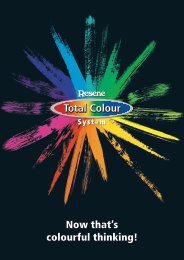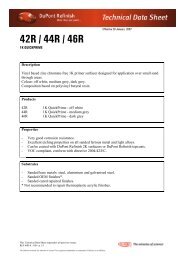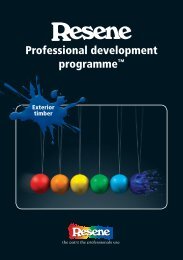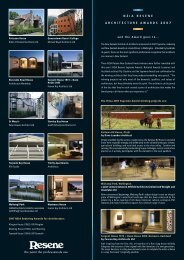Colour Choices - choose colour with creativity and ... - Resene
Colour Choices - choose colour with creativity and ... - Resene
Colour Choices - choose colour with creativity and ... - Resene
Create successful ePaper yourself
Turn your PDF publications into a flip-book with our unique Google optimized e-Paper software.
Sunlight energy is made up of 44% visible light, 5% ultra-violet light <strong>and</strong><br />
51% infra-red light.<br />
Traditionally light reflectance values have been used to define what<br />
<strong>colour</strong>s are suitable for heat prone substrates, however visible light<br />
reflectance values only measure a proportion of the light <strong>and</strong> ignore the<br />
effects of ultra-violet <strong>and</strong> infra-red light. Total Solar Reflectance (TSR)<br />
values take into account all three forms of light to give a better measure<br />
of the reflectance of the <strong>colour</strong>. A <strong>Resene</strong> Cool<strong>Colour</strong> uses pigments<br />
that reflect more of the sun’s energy resulting in the same visible light<br />
reflectance value as the st<strong>and</strong>ard <strong>colour</strong> but a considerably higher Total<br />
Solar Reflectance value.<br />
The solar spectrum includes infra-red radiation that <strong>Resene</strong> Cool<strong>Colour</strong><br />
pigments are designed to reflect. Replacing the st<strong>and</strong>ard black pigment<br />
that absorbs all infra-red <strong>with</strong> a <strong>Resene</strong> Cool<strong>Colour</strong> black pigment reduces<br />
the heat absorption. Some blues, greens <strong>and</strong> reds are transparent to infrared<br />
radiation so are best used <strong>with</strong> a <strong>Resene</strong> Quick Dry or <strong>Resene</strong> Galvo-<br />
Prime to reflect infra-red that passes through these hues.<br />
In terms of technology, the <strong>Resene</strong> Cool<strong>Colour</strong> effect can also be seen<br />
in plants. Most plants have leaves of a very high chroma green. If those<br />
leaves reached the same temperature when exposed to solar radiation<br />
as those of a similarly <strong>colour</strong>ed paint they would shrivel <strong>and</strong> die. The fact<br />
they don’t is because that pigment – chlorophyll – absorbs what it needs<br />
from the visible range to photosynthesise but reflects the infra-red range,<br />
keeping the plant cool.<br />
<strong>Colour</strong> technology<br />
29

















